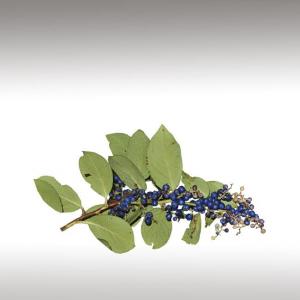
WINTERGREEN ESSENTIAL OIL (GAULTHERIA FRAGRANTISSIMA) - ESSENTIAL OILS

BASE / GENERAL DATA
Information submited: January 27, 2016 Modified: March 7, 2018 By: OperaDreamhouse
Botanical Name: Gaultheria fragrantissima
Botanical Origin: Nepal
Common Method of Extraction: Steam distillation
Part Typically Used: Leaves / Tops
Color: Pale yellow or yellowish or pinkish
Consistency: Thin
Perfumery Note: Top / Middle
Shelf Life: 7+ years
Strength of Initial Aroma: Wintgergreen (leaf) oil has a sweet, minty aroma with slight birch tones. Strongly aromatic with a sweet characteristic odor, displaying a peculiar creamy-fruity top note and a sweet-woody dry out.
Blends Well With: Lavender, Lime, Orange, Peppermint, Rosemary, Clove, Tea Tree, Sweet Anise, Nutmeg essential oil.
Common name :
French:Thé des bois, gaulthérie odorante
Chemical structure: Essential oil of gaultheria is composed of nearly 99% methyl salicylate. It is thus one of the rare essential oils to be almost mononuclear.
Gaultheria is a small shrub less than fifteen centimetres tall of the Ericaceae family, which grows in the forests of Nepal (Gaultheria fragrantissima syn. Punctata) as well as in China.
An evergreen herb growing up to 5-6 m high with slender creeping stems producing leathery leaves, white flowers, and red berries. Wall which is collected from 1200-2600m on rocky hill sides in forested areas of Nepal. The fresh twigs and leaves are very aromatic.
Gaultheria is nowadays mainly harvested in Nepal, in the Himalayas. In this country, the plant is taller and easier to harvest than in North America where this back - breaking work which was reserved in the past for Indians, immigrant children and women, no longer attracts many volunteers.
Essential oil of Gaultheria is extracted from the leaves, which are soaked overnight in hot water to obtain methyl salicylate by enzymatic fermentation, and they are then distilled with steam. This fermentation releases the aromatic compound from its bond to complex sugars which are too heavy to be distilled by the steam.
The yield is of 1.5% to 2%, one hundred kilograms of leaves give a litre and a half of essential oil.
Gaultheria fragrantissima wallich is indigenous to India and the Indian Wintergreen essential oil has similar therapeutic properties just as the American Wintergreen essential oil.
Ayurveda, the ancient natural science of healing calls this herb as Gandapura and was used in many spiritual ceremonies where this sacred plant was trusted to bring harmony between earth and its inhabitants through its healing powers.
Organoleptic properties of Wintergreen oil were detected by expert nose and eyes. Appearance of oil was determined by eyes and aroma by nose.
Botanical Origin: Nepal
Common Method of Extraction: Steam distillation
Part Typically Used: Leaves / Tops
Color: Pale yellow or yellowish or pinkish
Consistency: Thin
Perfumery Note: Top / Middle
Shelf Life: 7+ years
Strength of Initial Aroma: Wintgergreen (leaf) oil has a sweet, minty aroma with slight birch tones. Strongly aromatic with a sweet characteristic odor, displaying a peculiar creamy-fruity top note and a sweet-woody dry out.
Blends Well With: Lavender, Lime, Orange, Peppermint, Rosemary, Clove, Tea Tree, Sweet Anise, Nutmeg essential oil.
Common name :
French:Thé des bois, gaulthérie odorante
Chemical structure: Essential oil of gaultheria is composed of nearly 99% methyl salicylate. It is thus one of the rare essential oils to be almost mononuclear.
Gaultheria is a small shrub less than fifteen centimetres tall of the Ericaceae family, which grows in the forests of Nepal (Gaultheria fragrantissima syn. Punctata) as well as in China.
An evergreen herb growing up to 5-6 m high with slender creeping stems producing leathery leaves, white flowers, and red berries. Wall which is collected from 1200-2600m on rocky hill sides in forested areas of Nepal. The fresh twigs and leaves are very aromatic.
Gaultheria is nowadays mainly harvested in Nepal, in the Himalayas. In this country, the plant is taller and easier to harvest than in North America where this back - breaking work which was reserved in the past for Indians, immigrant children and women, no longer attracts many volunteers.
Essential oil of Gaultheria is extracted from the leaves, which are soaked overnight in hot water to obtain methyl salicylate by enzymatic fermentation, and they are then distilled with steam. This fermentation releases the aromatic compound from its bond to complex sugars which are too heavy to be distilled by the steam.
The yield is of 1.5% to 2%, one hundred kilograms of leaves give a litre and a half of essential oil.
Gaultheria fragrantissima wallich is indigenous to India and the Indian Wintergreen essential oil has similar therapeutic properties just as the American Wintergreen essential oil.
Ayurveda, the ancient natural science of healing calls this herb as Gandapura and was used in many spiritual ceremonies where this sacred plant was trusted to bring harmony between earth and its inhabitants through its healing powers.
Organoleptic properties of Wintergreen oil were detected by expert nose and eyes. Appearance of oil was determined by eyes and aroma by nose.

SPIRITUAL PRACTISES DATA
Information submited: February 15, 2016 Modified: February 21, 2018 By: OperaDreamhouse
The strong aroma of Wintergreen essential oil improves attentiveness and stimulates the mind. Applying this oil to your skin is said to heighten the vibration of the body and accentuate sound.
Increased vibration helps in unveiling spiritual awareness and paves way to the harmony of self and divinity. This attribute has made Wintergreen oil to be an incredible part of the ancient chants (Mantras) and meditations where sound was used for adding spiritualstrength.
Can indicate that you have been hurt in relationships. You have been left or emotionally or mentally battered. It is time for you to heal the hurt and get on with your life. It is time to love again. Wintergreen balances the Heart chakra.
Increased vibration helps in unveiling spiritual awareness and paves way to the harmony of self and divinity. This attribute has made Wintergreen oil to be an incredible part of the ancient chants (Mantras) and meditations where sound was used for adding spiritualstrength.
Can indicate that you have been hurt in relationships. You have been left or emotionally or mentally battered. It is time for you to heal the hurt and get on with your life. It is time to love again. Wintergreen balances the Heart chakra.

MEDICINE / HEALTH DATA
Information submited: January 27, 2016 Modified: March 7, 2018 By: OperaDreamhouse
Therapeutic Properties :
Analgesic
Astringent
Carminative
Diuretic
Stimulant
Anodyne
Anti-rheumatic
Antispasmodic
Pregnancy / Lactation : Avoid if pregnant. Should be avoided in pregnancy and lactation.
Children: It is safest to consult a qualified aromatherapy practitioner before using oils with children. Use extreme caution when using essential oils with children and give children only the gentlest oils at extremely low doses. Avoid topical use on children under 7 years.
Wintergreen essential oil is used as a counterirritant in treating pain, sores, muscular pains, lower back pain, achy joints and inflammation, where counterirritants act by creating an irritable sensation that lessens swelling and pain in the tissues.
The analgesic, relaxant and anodyne properties of this oil cause numbness and warmth when applied on the painful area. It eliminates pain, reduce stress, drive away tension and induce good sleep by inhibiting the formation of prostaglandins responsible for causing pain. This is mainly due to the presence ofMethyl salicyclate which is equivalent to the conventional medicine Aspirin (the fundamental component of Aspirin is salicyclate).
Analgesic
Astringent
Carminative
Diuretic
Stimulant
Anodyne
Anti-rheumatic
Antispasmodic
Antiseptic
Aromatic
Emmenagogue
Contraindications : Use in small doses. Do not use if you are allergic to aspirin. If you are pregnant, epileptic, have liver damage, have cancer, or have any other medical problem, use essential oils only under the proper guidance of a qualified aromatherapy practitioner.
Aromatic
Emmenagogue
Contraindications : Use in small doses. Do not use if you are allergic to aspirin. If you are pregnant, epileptic, have liver damage, have cancer, or have any other medical problem, use essential oils only under the proper guidance of a qualified aromatherapy practitioner.
Ingesting Wintergreen essential oil should be strictly avoided as it is highly toxic and can cause serious health effects. 1 fl oz of this oil is equivalent to 171 adult aspirin tablets. Use it only as a topical application after diluting it with soothing carrier oils in 1:10 ratio. This oil has blood - thinning effects and should be avoided by people who are susceptible to aspirin.
Pregnancy / Lactation : Avoid if pregnant. Should be avoided in pregnancy and lactation.
Children: It is safest to consult a qualified aromatherapy practitioner before using oils with children. Use extreme caution when using essential oils with children and give children only the gentlest oils at extremely low doses. Avoid topical use on children under 7 years.
Wintergreen essential oil is used as a counterirritant in treating pain, sores, muscular pains, lower back pain, achy joints and inflammation, where counterirritants act by creating an irritable sensation that lessens swelling and pain in the tissues.
The analgesic, relaxant and anodyne properties of this oil cause numbness and warmth when applied on the painful area. It eliminates pain, reduce stress, drive away tension and induce good sleep by inhibiting the formation of prostaglandins responsible for causing pain. This is mainly due to the presence ofMethyl salicyclate which is equivalent to the conventional medicine Aspirin (the fundamental component of Aspirin is salicyclate).

BEAUTY / COSMETICS DATA
Information submited: February 15, 2016 Modified: February 21, 2018 By: OperaDreamhouse
Wintergreen essential oil used in some perfumery applications especially in forest type fragrances.

FOOD / COOKING DATA
COMMENTS
No comments.


